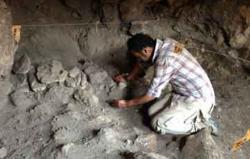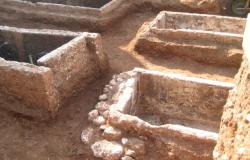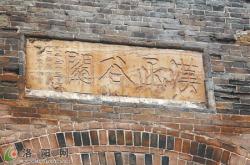INSTITUT SUPERIEUR D'ANTHROPOLOGIE
INSTITUTE OF ANTHROPOLOGY
ONLINE COURSES / COURS A DISTANCE
SUMMER TERM : JULY 2013
REGISTER NOW
MEXIQUE –  – Oxtotenco - Archaeologists have found traces of the Mezcala and Olmec cultures, as well as human remains, in a cave in the southern state of Guerrero, indicating that the site was inhabited at different times and served as a funerary center, the National Anthropology and History Institute, or INAH, said. Specialists found a Mezcala-type figure and campfire remnants dating to 700 A.D. in a cave in Cocula, a city in Guerrero, the INAH said in a statement. The figure is complete and important because of the limited number of finds of this type, INAH-Guerrero Center archaeologist Miguel Perez Negrete said. The Mezcala culture is one of the civilizations that developed along the Balsas River and is mainly identified on the basis of its architectural style and anthropomorphic figures. The discovery was made during construction of a road in Oxtotenco, a hamlet outside the community of Atzcala, Perez Negrete said. “The most surprising thing was that when we started digging, we also found Olmec ceramics estimaed to date to the year 1000 before our era, as well as pre-Olmec (1200 B.C.), that is, it is more than 3,000 years old,” the archaeologist said. The human remains consist of fragments and have not been dated yet, but they could be Olmec because of the ceramics associated with them, Perez Negrete said.
– Oxtotenco - Archaeologists have found traces of the Mezcala and Olmec cultures, as well as human remains, in a cave in the southern state of Guerrero, indicating that the site was inhabited at different times and served as a funerary center, the National Anthropology and History Institute, or INAH, said. Specialists found a Mezcala-type figure and campfire remnants dating to 700 A.D. in a cave in Cocula, a city in Guerrero, the INAH said in a statement. The figure is complete and important because of the limited number of finds of this type, INAH-Guerrero Center archaeologist Miguel Perez Negrete said. The Mezcala culture is one of the civilizations that developed along the Balsas River and is mainly identified on the basis of its architectural style and anthropomorphic figures. The discovery was made during construction of a road in Oxtotenco, a hamlet outside the community of Atzcala, Perez Negrete said. “The most surprising thing was that when we started digging, we also found Olmec ceramics estimaed to date to the year 1000 before our era, as well as pre-Olmec (1200 B.C.), that is, it is more than 3,000 years old,” the archaeologist said. The human remains consist of fragments and have not been dated yet, but they could be Olmec because of the ceramics associated with them, Perez Negrete said.
http://www.hispanicallyspeakingnews.com/latino-daily-news/details/mexican-archaeologists-discover-items-from-mezcala-olmec-cultures-in-abando/24948/
GRECE –  Gonnoi - Significant finds came to light last Monday in a cemetery dated to the Classical and Hellenistic period, in Gonnoi of the Larissa region (Thessaly, Greece), according to the newspaper “Eleftheria”. The cemetery was located after citizens informed the police about an illegal excavation. Members of the 15th Ephorate of Prehistoric and Classical Antiquities and policemen of the Rapsani Station rushed to the spot. The excavation was continued by the 15th EPCA throughout the day, supervised by archaeologist Mina Tsiata and the guard Nikos Vogias. The finds, among which were grave stelae, inscriptions etc., have already been moved to a secure place.
Gonnoi - Significant finds came to light last Monday in a cemetery dated to the Classical and Hellenistic period, in Gonnoi of the Larissa region (Thessaly, Greece), according to the newspaper “Eleftheria”. The cemetery was located after citizens informed the police about an illegal excavation. Members of the 15th Ephorate of Prehistoric and Classical Antiquities and policemen of the Rapsani Station rushed to the spot. The excavation was continued by the 15th EPCA throughout the day, supervised by archaeologist Mina Tsiata and the guard Nikos Vogias. The finds, among which were grave stelae, inscriptions etc., have already been moved to a secure place.
http://www.archaiologia.gr/en/blog/2013/06/06/ancient-cemetery-came-to-light/
ROYAUME UNI –  Clare - Human remains have been found during an archaeological dig in Clare Castle Country Park, revealing the location of a Christian burial site previously unknown to historians. The three sets of remains were found during a nine-day dig led by a team of ten archaeologists from Access Cambridge Archaeology (ACA). The dig, which saw four trenches excavated at different locations within the grounds of Clare Castle, was part of the Managing a Masterpiece project, which aims to find out more about the history of the Stour Valley landscape and discover how traditional land management has shaped it. Probably the most exciting discovery of the nine days was that of the human remains, one set of which belonged to a ten to 12-year-old child and another to a baby or infant, while the age of the third was undetermined. Because only the feet and legs were found the gender of those buried could not be established, but the findings proved very exciting, particularly as the trench they were found in was only dug to assess damage caused by building of the railway line in 1865. Dr Lewis explained: “We didn’t know there was a church here with burial rites. “It probably explains why the castle is situated here and not the other side of town. Because the bodies were laid out east to west the burial site is a Christian one, explained Dr Lewis, but although documentary evidence suggests a small priory was inside the grounds of the castle by 1045 AD (the castle was built within 24 years of the Norman conquest in 1066) the evidence of the findings suggests the graveyard did not belong just to the priory. Dr Lewis said: “We don’t know if this was a high status site. The fact that it was a young person suggests it’s not just this priory. “At ten to 12-years-old it could have been a novice monk, but normally children don’t enter into monastery until the age of 14. “We had no idea of this being here. This is completely new and the burial is early Christian. For there to be a burial here there must have been a church.” The remaining trenches also threw up some exciting discoveries of the Anglo-Saxon and post-Norman conquest period, added Dr Lewis. One trench contained evidence, including expensive pottery and deer bones, that showed the wealthy lifestyle enjoyed by Clare Castle’s owner in the 14th century. Elizabeth de Burgh, who at the time was one of England’s most prominent aristocrats. Another trench showed what Dr Lewis believed was the remains of a chapel built in the 1200s and refurbished in the 1400s before being demolished in the 1600s.
Clare - Human remains have been found during an archaeological dig in Clare Castle Country Park, revealing the location of a Christian burial site previously unknown to historians. The three sets of remains were found during a nine-day dig led by a team of ten archaeologists from Access Cambridge Archaeology (ACA). The dig, which saw four trenches excavated at different locations within the grounds of Clare Castle, was part of the Managing a Masterpiece project, which aims to find out more about the history of the Stour Valley landscape and discover how traditional land management has shaped it. Probably the most exciting discovery of the nine days was that of the human remains, one set of which belonged to a ten to 12-year-old child and another to a baby or infant, while the age of the third was undetermined. Because only the feet and legs were found the gender of those buried could not be established, but the findings proved very exciting, particularly as the trench they were found in was only dug to assess damage caused by building of the railway line in 1865. Dr Lewis explained: “We didn’t know there was a church here with burial rites. “It probably explains why the castle is situated here and not the other side of town. Because the bodies were laid out east to west the burial site is a Christian one, explained Dr Lewis, but although documentary evidence suggests a small priory was inside the grounds of the castle by 1045 AD (the castle was built within 24 years of the Norman conquest in 1066) the evidence of the findings suggests the graveyard did not belong just to the priory. Dr Lewis said: “We don’t know if this was a high status site. The fact that it was a young person suggests it’s not just this priory. “At ten to 12-years-old it could have been a novice monk, but normally children don’t enter into monastery until the age of 14. “We had no idea of this being here. This is completely new and the burial is early Christian. For there to be a burial here there must have been a church.” The remaining trenches also threw up some exciting discoveries of the Anglo-Saxon and post-Norman conquest period, added Dr Lewis. One trench contained evidence, including expensive pottery and deer bones, that showed the wealthy lifestyle enjoyed by Clare Castle’s owner in the 14th century. Elizabeth de Burgh, who at the time was one of England’s most prominent aristocrats. Another trench showed what Dr Lewis believed was the remains of a chapel built in the 1200s and refurbished in the 1400s before being demolished in the 1600s.
http://www.haverhillecho.co.uk/news/latest-news/burial-site-unearthed-in-clare-1-5159273
CHINE –  Hangu Pass - Recently, a new discovery in Hangu Pass found by the Luoyang Institute of Cultural Relics and Archaeology suggests that Hangu Pass is not only a pass, but once was also a city. The discovery will contribute to the study of passes in the Qin and Han dynasties and the Silk Road's application for World Cultural Heritage status. Hangu Pass is located at Xin'an County. The extant ruins were repaired in 1923 and include a custom house, Jiming Tower, Wangqi Tower and the south and north walls of the pass. The latest discovery suggests that Hangu Pass was a sophisticated defense system and city with a road, barricade, and fire tower beacon. Archaeologists found the south and east wall of the city south of Wangqi Tower. In addition, they found a ramp way in the south wall of the pass city, which is thought to be a drainage facility. Ruins of the early road were found, which was likely to be a part of the ancient road of the Qin Dynasty, and foundations of houses were discovered nearby.
Hangu Pass - Recently, a new discovery in Hangu Pass found by the Luoyang Institute of Cultural Relics and Archaeology suggests that Hangu Pass is not only a pass, but once was also a city. The discovery will contribute to the study of passes in the Qin and Han dynasties and the Silk Road's application for World Cultural Heritage status. Hangu Pass is located at Xin'an County. The extant ruins were repaired in 1923 and include a custom house, Jiming Tower, Wangqi Tower and the south and north walls of the pass. The latest discovery suggests that Hangu Pass was a sophisticated defense system and city with a road, barricade, and fire tower beacon. Archaeologists found the south and east wall of the city south of Wangqi Tower. In addition, they found a ramp way in the south wall of the pass city, which is thought to be a drainage facility. Ruins of the early road were found, which was likely to be a part of the ancient road of the Qin Dynasty, and foundations of houses were discovered nearby.
http://english.peopledaily.com.cn/90782/8274338.html
ROYAUME UNI –  Exceat - Archaeologists are using survey equipment to find out more about a lost medieval village in East Sussex. Exceat village, now lost beneath downland near Seaford, is being mapped by GPS surveyors who are also carrying out a geophysical survey of land surrounding the foundations of a stone church that was rediscovered 100 years ago. A team from Cuckmere Archaeology has brought in a ground penetrating radar to check the site in 20-metre sections. Records show that Exceat had a church in 1255, but the village is thought to have disappeared within 100 years after being attacked by the French and then falling victim to the Black Death. Initial excavations were carried out in 1913 after the teenage son of a local rector spotted the outline of a building in the field after the hot summer. Investigations at the time uncovered a small church, with walls up to five feet thick in places. It’s believed the church may have been the smallest in Sussex, with a nave measuring just 31 feet long. The original investigation found broken pottery around the church but no signs of other buildings. It’s hoped the modern survey equipment now being used will be able to discover traces of the lost settlement.
Exceat - Archaeologists are using survey equipment to find out more about a lost medieval village in East Sussex. Exceat village, now lost beneath downland near Seaford, is being mapped by GPS surveyors who are also carrying out a geophysical survey of land surrounding the foundations of a stone church that was rediscovered 100 years ago. A team from Cuckmere Archaeology has brought in a ground penetrating radar to check the site in 20-metre sections. Records show that Exceat had a church in 1255, but the village is thought to have disappeared within 100 years after being attacked by the French and then falling victim to the Black Death. Initial excavations were carried out in 1913 after the teenage son of a local rector spotted the outline of a building in the field after the hot summer. Investigations at the time uncovered a small church, with walls up to five feet thick in places. It’s believed the church may have been the smallest in Sussex, with a nave measuring just 31 feet long. The original investigation found broken pottery around the church but no signs of other buildings. It’s hoped the modern survey equipment now being used will be able to discover traces of the lost settlement.
http://www.surveyequipment.com/news/article/gps-survey-equipment-helping-to-uncover-lost-village-190617.html
INDE – Ahiran - Five days after gold coins believed to be of the Gupta period were unearthed at a road construction site in Ahiran, Murshidabad, there is no clarity on the follow-up action to the discovery. Eleven coins are now at the Murshidabad treasury. Over 50 coins believed to date from the times of Samudragupta and Chandragupta II were discovered on May 31 by labourers engaged in widening National Highway 34. The coins were found in soil cut from a mound in nearby Atpara. "Some labourers saw something glittering, and picked them out of the soil. Soon more such objects were found; they turned out to be gold coins. Gautam Sengupta, Director of archaeology directorate, said, "This discovery means that there was commercial activity (during Gupta period) there. The Brahmi inscriptions show that they belonged to the time of Chandragupta II and Samudragupta."
http://www.indianexpress.com/news/gupta-era-coins-found-in-bengal/1125781/
RUSSIE – Moscou - Rare archaeological artifacts were found during the restoration works on Pekin Hotel Complex and surrounding buildings. Thanks to their high historical value the findings are considered to be the items of the cultural heritage of the Russian capital. As a result of its ongoing excavations Arkheologicheskiye Izyskaniya v Stroitelstve Company has found over 350 historical artifacts dating between XVI and XX centuries since March 2013, including unique Dutch tiles demonstrating the evolution of ceramics crafts in Moscow spanning from XVII to XIX centuries. In addition, the archaeological company discovered articles of daily use and handicrafts made of leather and wood in nearly-mint condition. "Well-preserved items of everyday use are found very infrequently in Moscow's sandy soil. That is why the discovered objects have such a high historical value. This time the archaeologists found pieces of footwear, partially preserved horse harness, a part of a waist bag and a stair-shaped leather amulet crafted by Old Believers. All of these items were kept preserved in the deeper archaeological layers unspoiled by the bacteria. We are really lucky to see these items having survived until now," said Leonid Kondrashov, Moscow's chief archaeologist. "We uncovered hollow glazed finish tiles covered in etchings, which are typically united by common themes. Such Dutch tiles were used for decoration and heat-preservation by Moscow's homeowners. The tiles will help our experts establish the dates of the archaeological layers and the associated findings," said Vladimir Berkovitch, an archaeologist and deputy director general at Arkheologicheskiye Izyskaniya v Stroitelstve, LLC. The company has been doing excavations on the site where Tverskaya-Yamskaya village was located between the XVII and XIX centuries. Two excavation sites each measuring at 120 sq. m. were used for archaeological works. More than 3 meters deep, the cultural layers from various historical periods encompassed an archaeological layer at least one meter in depth left by this historical village.
http://www.4-traders.com/HALS-DEVELOPMENT-OAO-9059773/news/Hals-Development-OAO-Unique-XVI-%96-XX-Century-Archaeological-Artifacts-Found-during-Restoration-of-17008321/